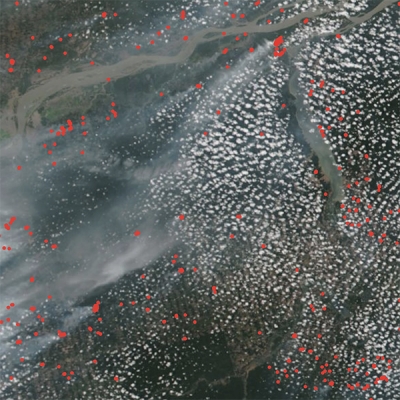We are excited to announce the VIIRS Nighttime Imagery (Day/Night Band, Enhanced Near Constant Contrast) layer has been added to GIBS and Worldview!
This imagery shows the earth’s surface and atmosphere using a sensor designed to capture low-light emission sources, under varying illumination conditions. It is displayed as a grey-scale image. Sources of illumination include both natural and anthropogenic sources of light emissions. Lunar reflection can be used to highlight the location and features of clouds and other terrestrial features such as sea ice and snow cover when there is partial to full moon conditions. When there is no moonlight, natural and anthropogenic night time light emissions are highlighted such as city lights, lightning, auroras, fires, gas flares, and fishing fleets.
This layer is useful for showing patterns of human activity and energy behaviors such as cities and highways, the holiday periods, the tracking of shipping and fishing fleets at night and, the burning of waste natural gas (gas flares) from on and off shore oil/gas production sites.
Examples of the VIIRS Nighttime Imagery (Day/Night Band, Enhanced Near Constant Contrast)
City and highway lights in the US on 23 January 2017
Fishing vessels off the eastern coast of South Korea on 9 January 2017
Fires in Central Chile (shown as red dots) and city lights on 22 January 2017
City Lights in the Nile River Delta, Egypt on 10 January 2017
This layer is updated daily, unlike the VIIRS Earth at Night 2012 image. The 2012 Earth at Night image was an image composite assembled from clear, cloud free images from 9 days in April 2012 and 13 days in October 2012.
The VIIRS Nighttime Imagery (Day/Night Band, Enhanced Near Constant Contrast) layer is available from the Visible Infrared Imaging Radiometer Suite (VIIRS) on the joint NASA/NOAA Suomi National Polar orbiting Partnership (Suomi-NPP) satellite. The sensor resolution is 750 m at nadir, imagery resolution is scaled to 500 m, temporal resolution is daily and temporal range for viewing in Worldview/Global Imagery Browse Services (GIBS) is 30 November 2016 - present.
Read more: Bringing Light to the Night: New VIIRS Nighttime Imagery Available through GIBS
References
Lee, T., S. Miller, F. Turk, C. Schueler, R. Julian, S. Deyo, P. Dills, and S. Wang, 2006: The NPOESS VIIRS Day/Night Visible Sensor. Bull. Amer. Meteor. Soc., 87, 191–199, doi: 10.1175/BAMS-87-2-191.; The Lights of London. NASA Earth Observatory; Out of the Blue and Into the Black. NASA Earth Observatory; Román, M. O. and Stokes, E. C. (2015), Holidays in lights: Tracking cultural patterns in demand for energy services. Earth's Future, 3: 182–205. doi:10.1002/2014EF000285




